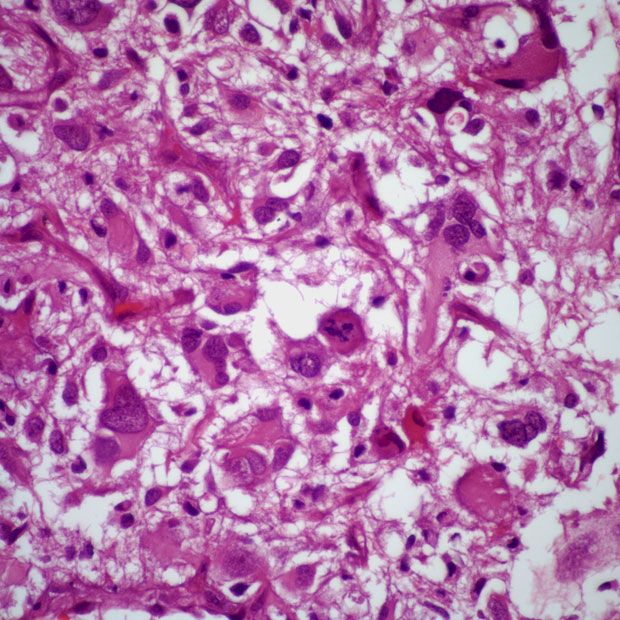Vorasidenib Significantly Improves PFS Vs Placebo in IDH+ Glioma
Investigators also report an improvement in time to next intervention with vorasidenib compared with placebo among patients with IDH-mutated glioma in the phase 3 INDIGO trial.
Investigators of the international, double-blind phase 3 INDIGO trial (NCT04164901) evaluated the safety and efficacy of vorasidenib as a treatment for patients with residual or recurrent grade 2 IDH-mutated glioma.

Treatment with vorasidenib produced significant improvements in progression-free survival (PFS) and time to the next intervention vs placebo in patients with grade 2 IDH-mutated glioma, according to findings from the phase 3 INDIGO trial (NCT04164901) published in New England Journal of Medicine.1
The imaging-based PFS per blinded independent review was 27.7 months (95% CI, 17.0-not estimable [NE]) in patients treated with vorasidenib vs 11.1 months (95% CI, 11.0-13.7) in those receiving placebo (HR, 0.39; 95% CI, 0.27-0.56; P <.001). Additionally, similar benefit was observed with regard to investigator-assessed PFS in the vorasidenib arm as seen in the primary analysis (HR, 0.35; 95% CI, 0.23-0.54).
Investigators noted a significant improvement in time to the next intervention in patients receiving vorasidenib vs those receiving placebo (HR, 0.26; 95% CI, 0.15-0.43; P <.001). In the experimental and placebo arms, respectively, the probability of survival and not receiving an additional line of treatment intervention was 85.6% (95% CI, 77.8%-90.8%) vs 47.4% (95% CI, 35.8%-58.2%) at 18 months and 83.4% (95% CI, 74.0%-89.6%) vs 27.0% (95% CI, 7.9%-50.8%) at 24 months. Additionally, 11.3% and 35.6% of patients in each respective treatment group received another anti-cancer therapy.
Subgroup analyses highlighted PFS and time to the next intervention benefits with vorasidenib across most subgroups, including those based on 1p/19q codeletion status.
“It used to be that we thought of all gliomas as being on a spectrum…. We now understand that those with the IDH gene mutation have a markedly different biology, outcome, and, as [the INDIGO trial] shows, vulnerabilities that new therapies can exploit,” David Schiff, MD, co-director of the University of Virginia Cancer Center’s Neuro-Oncology Center, stated in an editorial published in the New England Journal of Medicine.2
“There are still many unanswered questions about how we can best utilize [vorasidenib] if and when it receives FDA approval…. Nonetheless, considering that existing standard therapies for these tumors [radiation and chemotherapy] are tough on patients with short- and long-term [adverse] effects [AEs], it will be wonderful to have a useful and very well-tolerated treatment option.”
Investigators of the international, double-blind INDIGO trial evaluated the safety and efficacy of vorasidenib as a treatment for patients with residual or recurrent grade 2 IDH-mutated glioma. Patients were randomly assigned to receive 40 mg of vorasidenib (n = 168) or matched placebo (n = 163) once a day as part of continuous 28-day cycles.
The trial’s primary end point was PFS as evaluated via imaging by blinded independent review. Secondary end points included time to next intervention, objective response rate, and safety.
Those 12 years and older with a Karnofsky performance status of at least 80 and a minimum of 1 prior surgery were able to enroll on the trial. Patients also needed to have no other anti-cancer treatment for glioma and no use of glucocorticoids for signs or symptoms of glioma to enroll.
The median patient age was 40.5 years (range, 21-71) in the vorasidenib group and 39 years (range, 16-65) in the placebo group. In the experimental and placebo groups, respectively, most patients were male (60.1% and 52.8%), from North American (51.2% and 65.6%), and had frontal tumors (63.7% and 70.6%). Most patients in each respective group had 1 prior surgery for glioma (75.0% and 82.2%), oligodendroglioma (52.4% and 51.5%), and IDH1-positive disease (97.0% and 93.3%).
Any-grade AEs occurred in 94.6% of patients receiving vorasidenib vs 93.3% of patients receiving placebo. Common any-grade AEs in each respective group included increased alanine aminotransferase (38.9% and 14.7%), COVID-19 (32.9% and 28.8%), fatigue (32.3% and 31.9%), and headache (26.9% and 27.0%).
Investigators reported grade 3 or higher AEs in 22.8% of those in the vorasidenib group and 13.5% in the placebo group. The most common grade 3 or higher AEs in patients receiving vorasidenib included increased alanine aminotransferase (9.6%), increased aspartate aminotransferase (4.2%), and seizure (4.2%). Common high-grade toxicities in the control arm included seizure (2.5%), fatigue (1.2%), and increased γ-glutamyltransferase (1.2%).
References
- Vorasidenib in IDH1- or IDH2-mutant low-grade glioma. N Engl J Med. 2023;389:589-601. doi:10.1056/NEJMoa2304194
- Schiff D. Headway against brain tumors with molecular targeting of IDH-mutant gliomas. N Engl J Med. 2023;389:653-654. doi:10.1056/NEJMe2305639